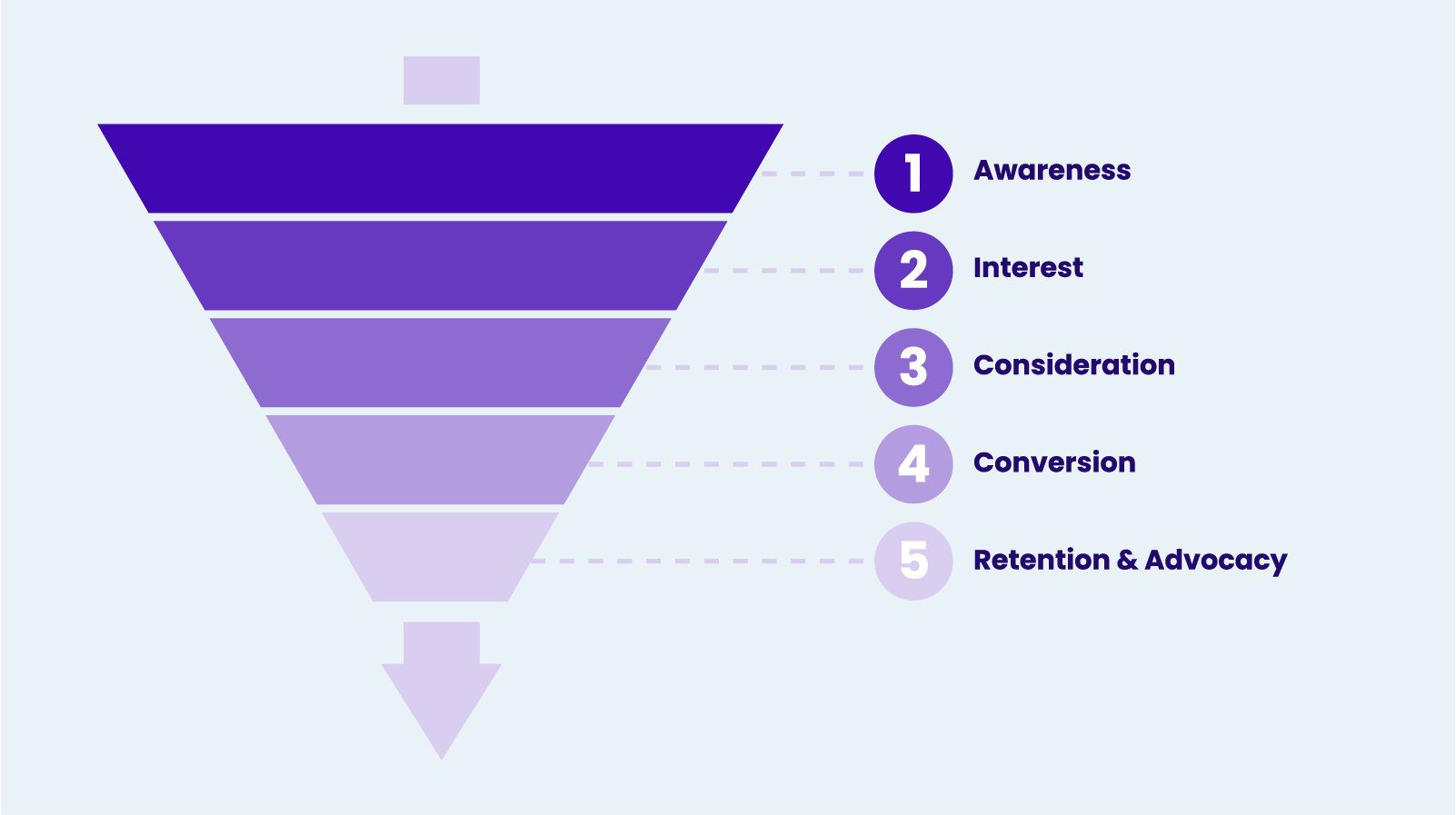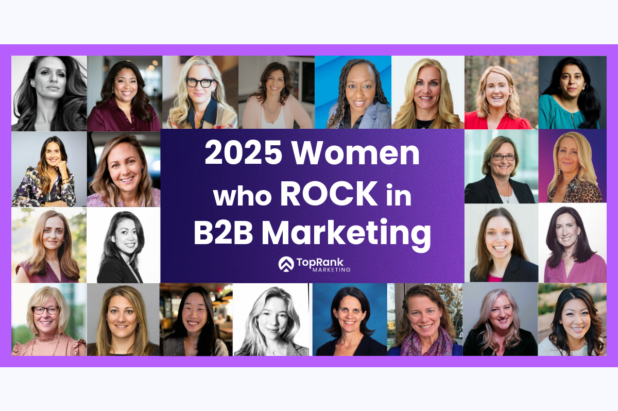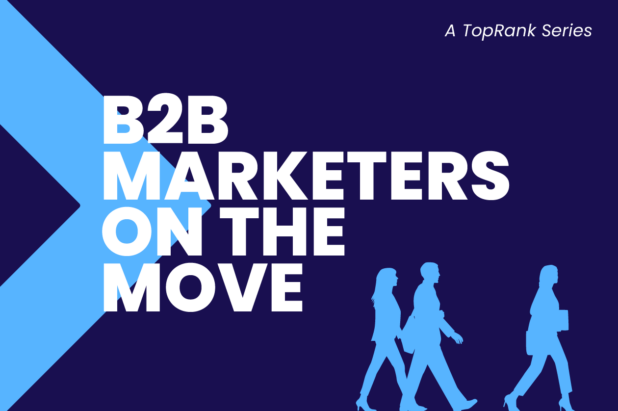The B2B marketing customer journey has always been nonlinear and unpredictable in nature. For B2B customers, the timeline from becoming aware of a need to actually buying a solution often takes several months, involving numerous checkpoints along the way.
As digital channels, user preferences, and B2B industries evolve, so too are the journeys that buyers follow to discover products and services that suit their needs.
What is the customer journey in B2B marketing?
The B2B customer journey refers to a set of steps or stages that take place on the path from being an unfamiliar prospect to a converted customer. This journey is framed from the audience’s point of view in order to help marketers understand and align with the varying motivations and needs at each progressive step.
B2B marketing strategies succeed by making it easier and more compelling for the target audience to move from one customer journey stage to the next. Your B2B marketing funnel should be tightly aligned to your customers’ journeys, with content and campaigns tailored accordingly.

In-market vs. out-market
Before we break out the various stages of the B2B customer journey, it’s useful to start with a broader categorization that can guide your marketing strategy at a high level: potential customers who are in-market vs. out-market.
- In-market: Buyers in your solution category with an active need for what you offer.
- Out-market: Buyers in your solution category who do not currently have a realized need, but will in the future.
Research by LinkedIn shows that at any given time, roughly 95% of potential customers in any given B2B category are “out-market.” They haven’t necessarily begun their customer journey yet but there is massive benefit in gaining mindshare with this outsized segment.
Many techniques and optimizations can be applied throughout the B2B customer journey, but for growth-focused organizations, attracting potential buyers during the very first step (awareness) is paramount. After all, a journey with your brand cannot be advanced or completed if it never begins.
Learn more: Today’s Top B2B Inbound Marketing Challenges
Stages of the B2B customer journey
Different frameworks and terminologies are used to represent the B2B marketing customer journey, but this six-stage model is common:
#1. Awareness: Buyer identifies a problem, pain point, or challenge that can be solved by your solution.
#2. Consideration: Buyer begins to explore vendors, providers or agencies capable of solving their needs. They begin narrowing their choices.
#3. Decision: After arriving at a final set of options, the buyer reaches a purchase decision. This stage often includes discussions around pricing and contract negotiations.
#4. Purchase: The actual purchase takes place, with agreements finalized, contracts signed and payments completed.
#5. Implementation: Buyer adopts and implements the new solution into their business, often with ongoing service from the seller.
#6. Support and retention: The continuing relationship between a converted customer and the brand. Successful marketing at this stage can lead to retention, renewals, and upsells.
How customer journeys are evolving in B2B
Many forces are at play in reshaping the B2B customer journey before our eyes.
Maturity of digital transformation
Over the years, business has increasingly gone digital. The number of online touchpoints involved with a B2B customer journey has dramatically increased, while the relative proportion of face-to-face interaction has shrunk. Trends like AI personalization and the rise of self-serve buying are fundamentally changing the dynamics of B2B purchasing.
By 2025, 80% of B2B sales interactions between suppliers and buyers will occur in digital channels. (Gartner)
Expansion of B2B content and engagement channels
McKinsey found in 2021 that B2B customers regularly used 10 or more channels to interact with suppliers, up from five in 2016. Omni-channel marketing has widely taken hold as brands keep pace with a sprawling media landscape.
Accounting for the changing ways that people engage with brands – websites, social media, mobile, search, connected TV, and even offline channels – means marketers need to keep an agile and experimental mindset.
Economic trends and budget impacts
As the world continues to navigate economic uncertainty, the effects naturally reverberate into discretionary spending. B2B purchases deemed non-essential tend to be scrutinized more heavily, lengthening and sometimes halting customer journeys.
Research in 2023 found that buyers were conducting more thorough ROI analysis and spending more time researching purchase decisions.
Read more on our blog: How B2B Marketers Are Responding to Tough Market Conditions
Shifts in decision-making dynamics
One of the core differentiators between B2B vs. B2C is the practice of marketing to a buying committee as opposed to a single consumer. By necessity, B2B buying is a team game often encompassing many decision makers, stakeholders, and influencers.
These group structures are fluid across organizations, within organizations, and over time. Different buying committee roles can have very different needs, interests, and search intent.
Customer journey mapping for B2B marketers
Used to gain an understanding of how people interact with your brand at various stages, customer journey mapping is a valuable exercise. Here’s how you can do it:
1. Define your customer journey stages
The framework laid out above serves as a standard paradigm, but customer journeys can be customized and configured according to the business model and marketing strategy.
For example, a SaaS brand selling a subscription-based service will place a greater emphasis on the retention stage compared to a manufacturing supplier that mostly engages in one-time sales. Another company might have an entire stage dedicated to referrals and advocacy.
2. Research and understand customer touchpoints
These are the pins you can place in your proverbial map – the key channels, platforms and destinations where customers encounter or interact with your brand along their journey. These can include your website, social media, search result pages, email, customer reviews, influencer content, and much more.
3. Gather and analyze customer data
Here’s where you start digging into the data you have available – first-party or zero-party data is most durable and dependable these days – and start to develop some insights to inform your customer journey map. You’ll want to associate different touchpoints, actions, and keywords with different stages using an intent-based approach.
4. Develop buyer personas
No two buyers are alike, but in most cases, you can categorize different types of ideal customers and key decision-making roles based on shared traits and needs. Developing buyer personas helps you personalize at scale, optimizing content for different stages and touchpoints.
5. Create a customer journey map
You can now take all of the information and insight compiled through the previous steps and organize it into a visual representation, depicting the sequential pathways that represent an ideal journey with your brand. This often takes the form of a flow chart or diagram, easily understood by those in marketing and beyond.
6. Identify opportunities and optimize
The real beauty of this exercise is the actionable data it can surface. Measuring and analyzing performance through the context of the customer journey helps you attain a holistic view of how buyers experience your brand. You can pinpoint strengths and weaknesses, identify gaps, and uncover new opportunities
Ready to dig deeper into the best practices of B2B marketing? Check out our full B2B marketing strategy guide.



